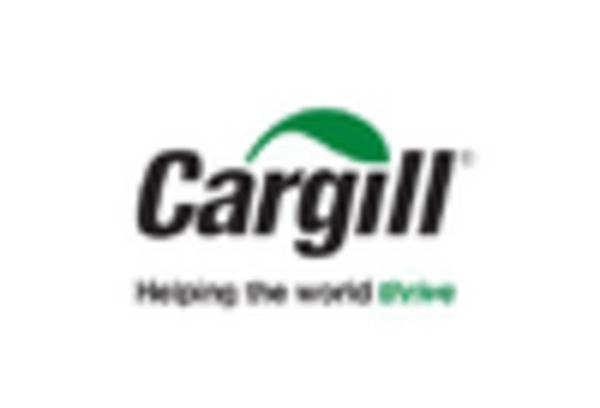Expansion of Distribution Channels
The vegetable puree market in Japan is benefiting from the expansion of distribution channels, which enhances product accessibility for consumers. The rise of e-commerce platforms and online grocery shopping has transformed the way consumers purchase food products, including vegetable purees. Recent data indicates that online grocery sales in Japan have surged, with a growth rate of approximately 20% annually. This shift suggests that the vegetable puree market is likely to see increased sales as more consumers turn to online shopping for convenience. Additionally, traditional retail channels are also evolving, with supermarkets and specialty stores expanding their offerings of vegetable purees. This diversification in distribution channels not only increases visibility but also caters to a broader audience, thereby fostering growth within the vegetable puree market.
Rising Demand for Plant-Based Foods
The vegetable puree market in Japan experiences a notable surge in demand for plant-based foods, driven by a growing health-conscious consumer base. As more individuals adopt vegetarian and vegan diets, the preference for vegetable purees as a nutritious alternative to traditional meat products increases. Recent data indicates that the plant-based food sector in Japan is projected to grow at a CAGR of approximately 10% over the next five years. This trend suggests that the vegetable puree market will likely benefit from this shift, as consumers seek healthier, plant-derived options. Furthermore, the increasing awareness of the health benefits associated with vegetable consumption, such as improved digestion and reduced risk of chronic diseases, further propels the market forward. Consequently, the vegetable puree market is poised to capitalize on this growing inclination towards plant-based diets.
Increased Focus on Clean Label Products
The vegetable puree market in Japan is witnessing a shift towards clean label products, reflecting consumer demand for transparency in food sourcing and ingredients. As consumers become more discerning about what they consume, they increasingly prefer products that contain minimal, recognizable ingredients. This trend is particularly relevant in the vegetable puree market, where the emphasis on natural and organic ingredients is paramount. Data suggests that the clean label market in Japan is projected to grow at a CAGR of around 8% over the next few years. This growth indicates that manufacturers are likely to reformulate their products to align with clean label standards, thereby enhancing the appeal of vegetable purees. As a result, the vegetable puree market is expected to adapt to these consumer preferences, potentially leading to increased sales and market penetration.
Growing Popularity of Ready-to-Eat Meals
The vegetable puree market in Japan is significantly influenced by the increasing popularity of ready-to-eat meals. As busy lifestyles become more prevalent, consumers are seeking convenient meal solutions that do not compromise on nutrition. Vegetable purees serve as an ideal ingredient in ready-to-eat meals, providing essential nutrients while offering ease of preparation. Recent statistics indicate that the ready-to-eat meal segment is expected to grow by approximately 15% in the coming years, which could lead to a corresponding increase in the demand for vegetable purees. This trend suggests that the vegetable puree market may experience substantial growth as manufacturers innovate and create new meal options that incorporate vegetable purees. The convenience factor, combined with the nutritional benefits of vegetable purees, positions the market favorably in the evolving food landscape.
Innovations in Food Processing Technology
Advancements in food processing technology significantly impact the vegetable puree market in Japan. Innovations such as high-pressure processing (HPP) and vacuum technology enhance the quality and shelf-life of vegetable purees, making them more appealing to consumers. These technologies not only preserve the nutritional value of vegetables but also improve flavor and texture, which are critical factors for consumer acceptance. The market is witnessing an increase in the introduction of new products that leverage these technologies, catering to the evolving tastes of Japanese consumers. Additionally, the integration of smart technology in food processing allows for better quality control and efficiency, potentially reducing production costs. As a result, the vegetable puree market is likely to see a rise in product offerings that meet the demands of quality-conscious consumers.

















Leave a Comment